A JAL (Japan Airlines) Airbus A350 burst into flames after landing, following what appears to be an impact with a Coast Guard aircraft.
THIS IS A DEVELOPING STORY, see updates at the end. It involves Japan Airlines flight JL516, a daily afternoon domestic flight, departing from Sapporo New Chitose Airport (RJCC) in Japan. Its destination is Tokyo Haneda International Airport (RJTT).
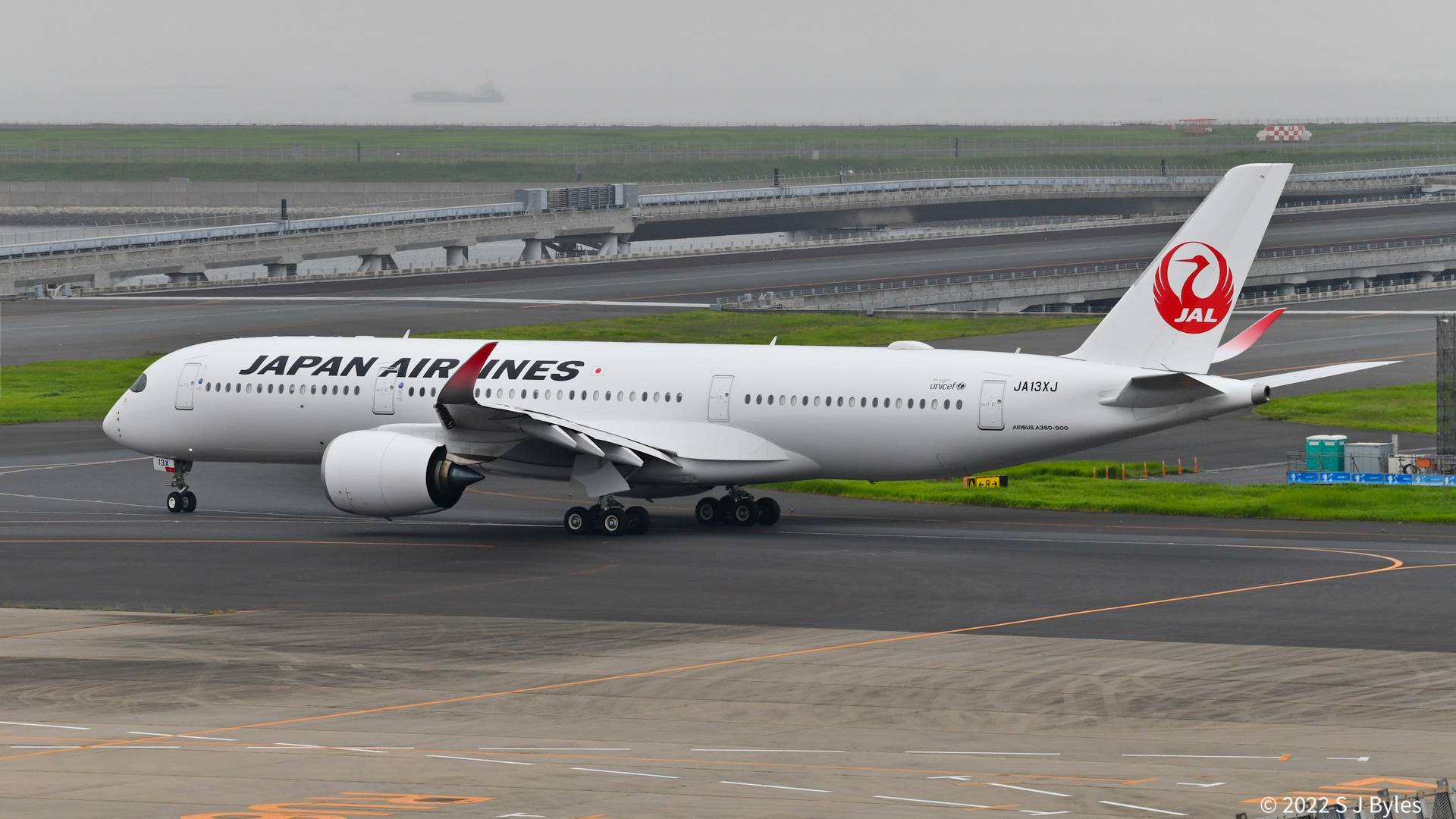
On the day of this accident, there were 367 passengers and 12 crew on board the JAL Airbus A350. The aircraft departed from Sapporo with a small delay (35 minutes) using runway 19R. But the 1h-20min flight seems to have otherwise been routine, until its arrival in Tokyo.
The JAL crew flying the Airbus A350 landed on runway 34R. Cameras show that the initial rollout of the aircraft was uneventful. But then the aircraft erupts in a ball of fire. There are reports that the Airbus hit a smaller aircraft, that belongs to the Japanese Coast Guard.
JAL Airbus A350, Coast Guard Dash-8-300
According to local media, everyone on board the JAL flight was able to evacuate safely before the Airbus A350 was completely destroyed. As of this writing, firefighting crews at the airport continue to fight the flames.
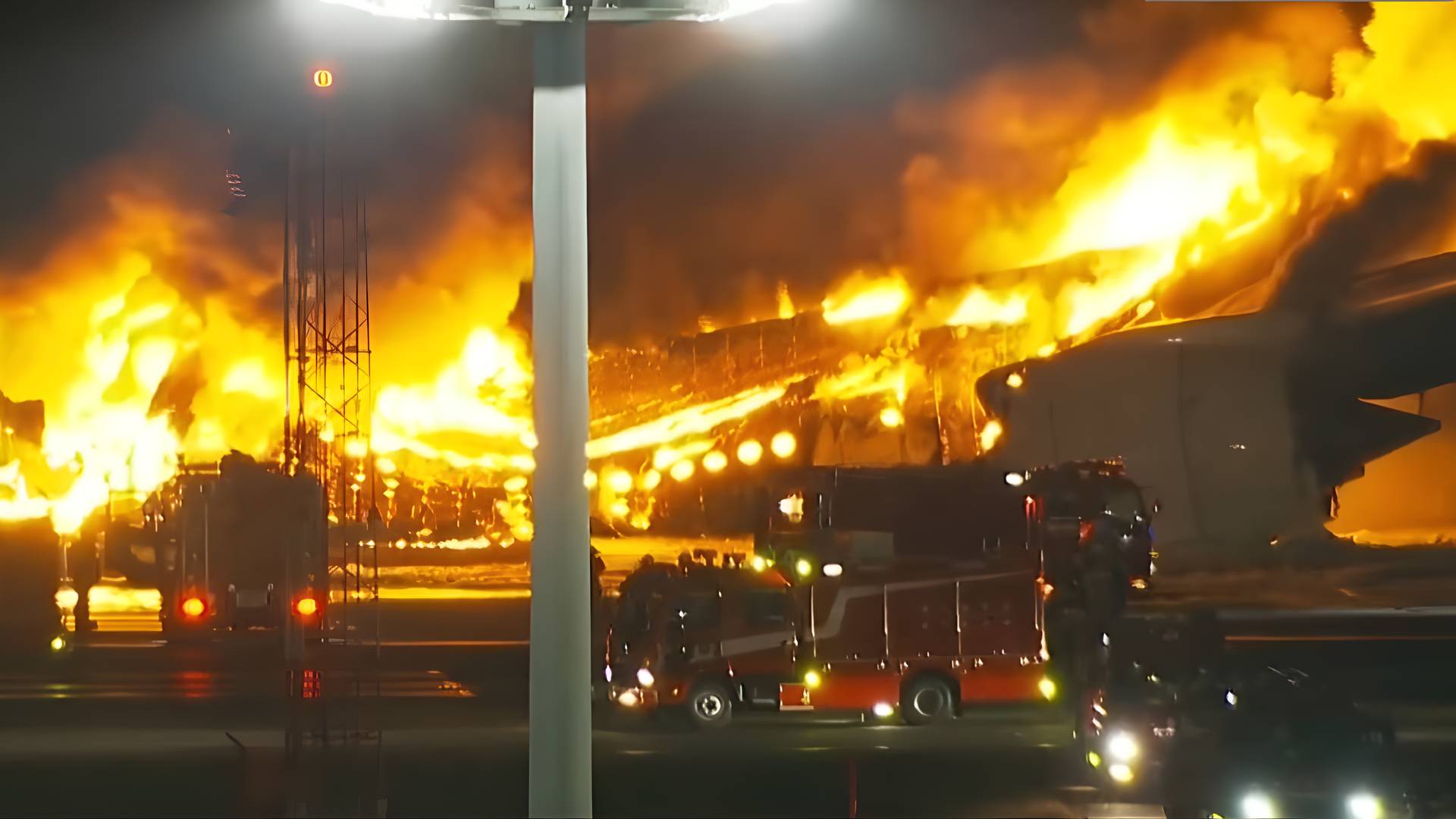
Unfortunately, there are few reports at this time on the fate of the six people on board the Coast Guard aircraft. Some sources say that one person has been rescued. This was a Bombardier (now De Havilland) Dash-8-300, with registration JA722A.
This aircraft was reportedly transporting people and supplies to Niigata Air Base, to assist in relief efforts relating to yesterday’s Noto Peninsula earthquake.
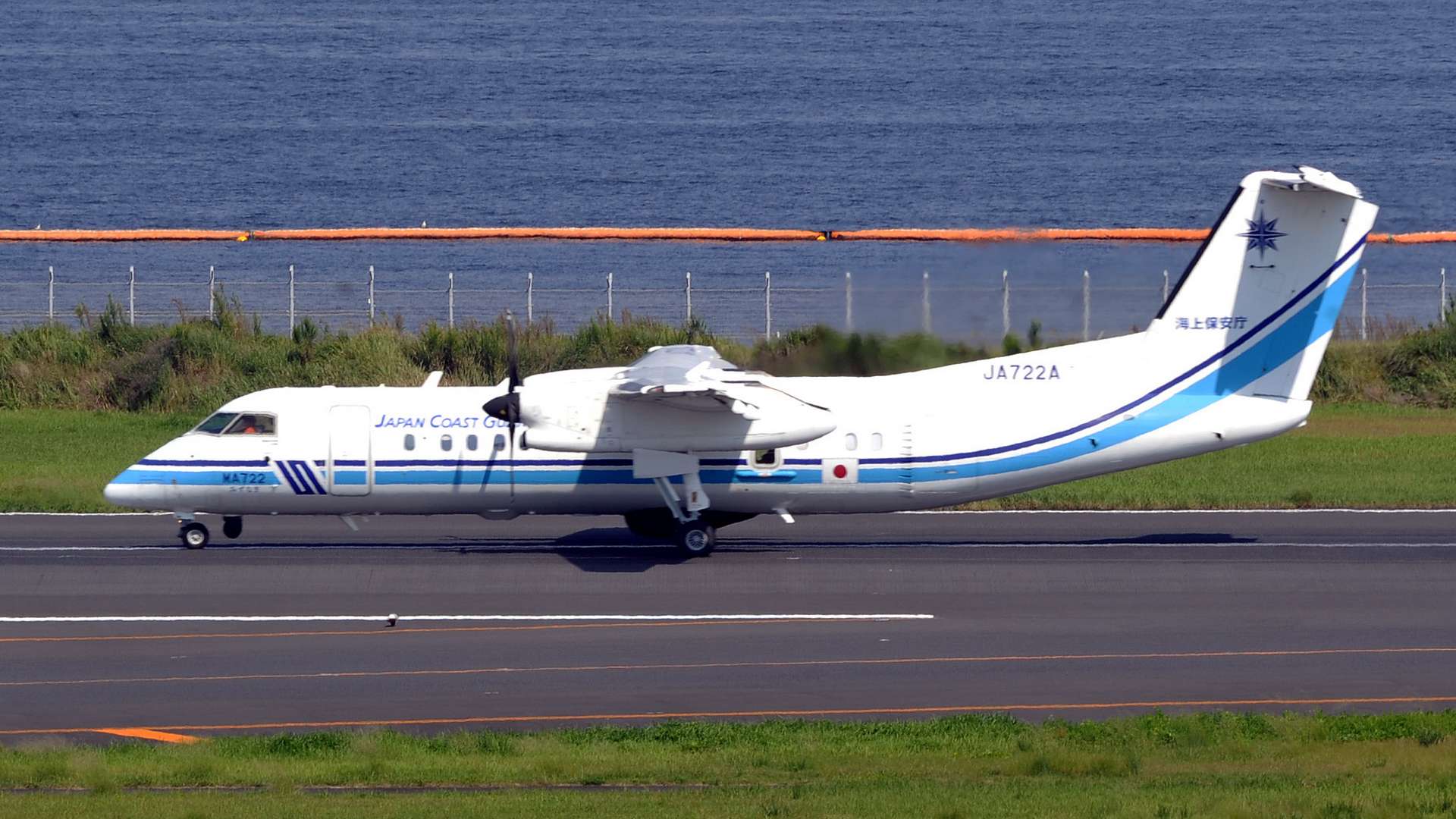
As for the larger aircraft, this appears to be the first hull loss of an Airbus A350. It is a two-year-old A350-900, with registration JA13XJ. The A350 has a carbon fiber fuselage and wing, and any difficulties in fighting fires involving composites will be of interest to investigators worldwide, in addition to other factors in this accident.
We will update this article when more news is available.
UPDATES
More photos of the Airbus A350 taken before it was consumed by the fire, show impact damage on its nose (see below).
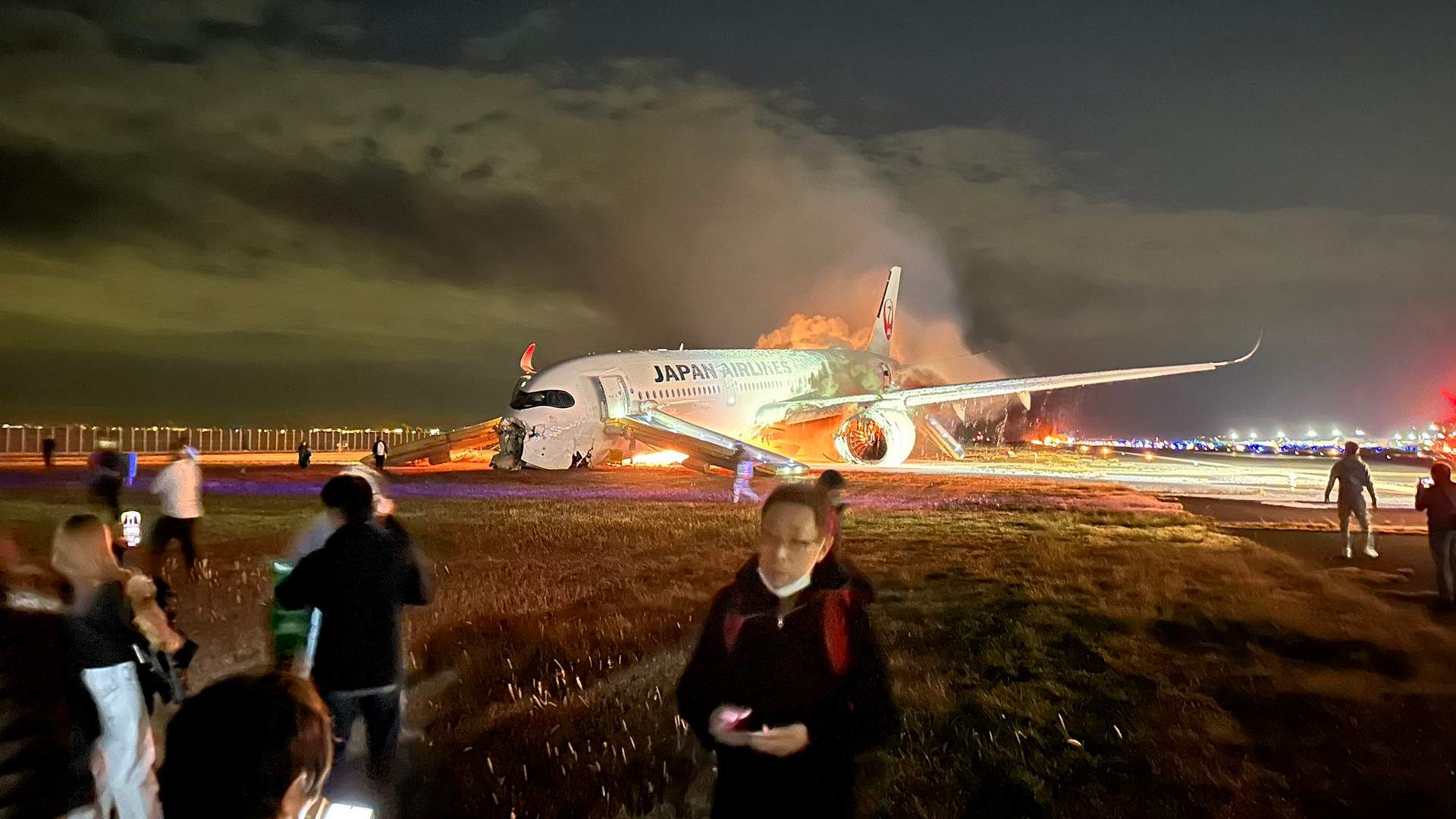
Tragically, news reports confirm that five out of six occupants in the Coast Guard aircraft did not survive the accident.
The sixth occupant is the aircraft’s Captain, who was able to evacuate the aircraft and is in serious condition. 14 passengers in the airliner required medical attention due to injuries. This number is revised down from 17.
Tokyo Haneda Airport closed after the accident, with flights diverting to Tokyo Narita Airport. France’s BEA is sending an investigating team to Japan.
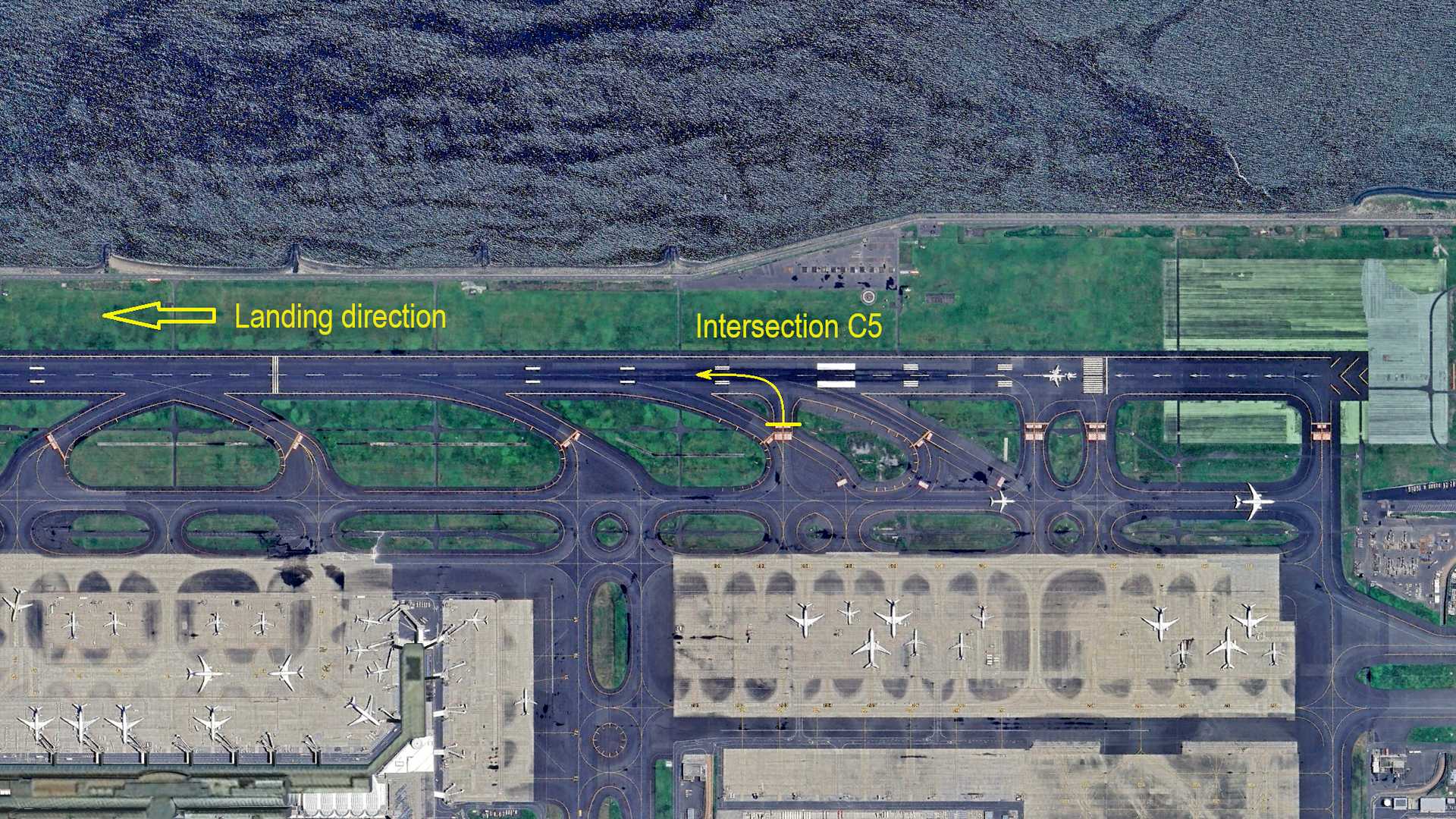
ATC audio reportedly indicates that the crew of the JAL Airbus A350 had been cleared to land. Then approximately 20 seconds later, the tower told the Coast Guard crew to taxi to intersection C5 (see above, corrected from C2 previously). According to this audio, the controller did NOT clear that aircraft to enter the runway.




70 comments
Sunflower
I’ve heard that Brisbane, Australia airport had a similar issue too.
James
It could have been that the warning system to tell air traffic controllers if a plane is not on the holding spot, wasn’t working properly.
Alex Kindberg
My guess is that while the Coast Guard crew was busy with pre-flight checklists in the dark, they either forgot that the stop bar lights were non-functioning and assumed that the ATC had changed its mind on the hold to allow them to enter the runway or missed the stop bar because it was dark and the lights were off. I guess we will see what the report says are the contributing factors.
G
I would ptrfer that only experienced professional pilots comment on these type accidents. Or are they going to be assertive if I ever make a mistake. A lot more goes on in a flight deck that we are not aware of when reading a story…
MICHAEL GREENBERG
Communications released by Ministry of Land, Infrastructure, Transport and Tourism indicate that JL516 had been cleared to land on runway 34R. JA722A had been instructed to hold short on taxiway C5. This instruction was read back correctly, however, the survived captain of DHC-8 asserted just after the accident that he had been cleared for takeoff, which is contrary to the ATC record.
Additionally, it appears the stop bar lights for taxiway C5 (and other taxiways) was unserviceable, as per Notam published on December 25: “STOP-BAR-LGT FOR C1 THRU C14-U/S”.
Some professional remarks:
At most major airports there are radar based Runway Safety Systems, alarming and preventing controllers from using the runway for landings/takeoffs, when it is occupied by another aircraft or vehicle
Intersection departures are not allowed during night hours, since the landing aircraft is unable to identify another aircraft located at the middle of the landing runway due to runway lights pollution.
The unserviceabllity of the stop bars, in addition to the Notam, should be stressed in the taxi clearance and on Atis info.
As a routine, the lining up aircraft crew should verify absence of landing traffic on final
topgun 145
this crash reminds me of Us Air 1493 and SkyWest Airlines Flight 5569 in 1991 at lax and scary part is both accidents are almost similar in how the crashes happened jal 516 and us air 1493 both hit the plane they crashed in to as the nose was being lowered on to the runway
Susan Jamieson
The C5 Coast Guard Pilot will have a lot of explaining to do about why he pulled out right in front of a huge well-lit passenger jet as it was touching down instead of holding. And a lifetime of guilt for killing 5 friends.
It appears the Japanese passenger jet was fully on the ground (per the big dent on its nose instead of under it) and going to slow (142?) to spool up and lift up again with just a couple seconds to act.
The other question is why didnt the air traffic controller didnt warn the CG Captain about the incoming flight or
Kelly Em
I am puzzled by the poor quality of the Tower audio, it was as if there was interference from some source or other.
Alton
Wouldn’t there have been TCAS and other warnings to stop this accident from happening? They would also have arc and other radios to hear that is going on.
Voidstarblade
Tcas is an In Air system, it does not work for on ground stuff. you may be thinking about RIMCAS, which is an on ground system. there is a video on a somewhat similer incident that turned out better because it happened during the day, https://www.youtube.com/watch?v=AM01NSZyA7I.
But the too long/didn’t watch summery is that RIMCAS needs time to calculate where everyone is, and the coast guard plane was told to stop and just didn’t stop where they were supposed to. they had the bad timing to roll out onto the runway just as the JAL plane was landing, leaving no time for anyone or anything to react.
Daniel
My only question in my mind now is WHAT WAS THE VISIBILITY &WEATHER in general?was VISIBILITY minimal to an extend the pilots could not see an obvious RUNWAY OBSTRACTION????
Caroline Benn
Wouldn’t ground radar have picked up on the DHC-8, even though it wasn’t equipped with ADS-B?
Dr. Swaterian Pharmacist
RIMCAS (Runway Information Monitoring and Collision Avoidance System) is the primary system to avoid such issues.
Was Tokyo Haneda Airport equipped with RIMCAS?
Voidstarblade
it probably would have, but given that the timing between the JAL plane being given landing clearance and the Coast guard plane being told to taxi to a waiting point was 20 seconds, there was probably no time to react once the coast guard plane went past the holding point onto the runway.
topgun 145
worse the dash 8 was sitting on the runway for 43 second’s
Caroline Benn
Gotcha, thanks Voidstarblade. I didn’t realise that it all happened that quickly – I’ve not looked at the radio communication timestamps.
[email protected]
One of the video reports Ive seen clearly shows the right engine still turning and emitting sparks. Also fuel pouring onto the runway. I think this will prove to be the cause of the total loss of hull. The engine could have lit the fuel and fanned it into a fire
Francis
I’m very interested in what the investigation has to reveal about the composite materials in reaction to fire in structural integrity in crew response and to passenger compliance to crew orders all played a part in the successful evacuation of the A350 I also would like to see what contributed to the Captain survival but not his crew in the coastguard plane praying for everyone that has been or will be involved in this tragic incident
Kyranoboss
There must be concerns about how a moderate to severe fire on the A350 quickly raged out of control. Even with fire crews on site they were unable to prevent the fire spreading and engulfing the whole aircraft. The materials used were clearly highly flammable and not amenable to being extinguished by established methods. There have been many incidents of fire on an aircraft, and at 35,000ft I would not fancy the chances of survival on that aircraft.
In mitigation one has to remember there were two accident sites. How did the immediate response crews divide their resources between the two sites?
It’s a miracle everyone managed to get off the A350 but also a tragedy for the families of the 5 people who perished on the Dash 8
That's Crazy
If the A350 has that issue I’m sure so is the 787 because they use the same materials.
Petter
We will keep updating this story, please continue to interact – We love seeing your passion for improved aviation safety.
Hanna
Apparently the Dash 8 was lined up on 34, (the source that gives this info says it was 34L but A350 landed on 34R). And the taxiway exit stop bar was inoperative (it’s possible Dash 8 entered thinking it was ok), mentioned in NOTAMs. And the TCAS unfortunately doesn’t work below 900 ft
Dr. Swaterian Pharmacist
Of course. TCAS is for in-the-air Traffic Collision Avoidance System. But a modern airport like Tokyo Haneda Airport should have been equipped with RIMCAS (Runway Information Management and Collision Avoidance System). Why didn’t that work?
Patrick Brown
What an endorsement for the A350. The fact that the fuselage remained intact, despite the collision and then withstood a raging fuel fire long enough to totally evacuate the aircraft is testimony indeed.
The Loungeman Music
I may get punched in the face for this because I’m not a pilot (but fascinated by aviation).
I’ve heard of stories where pilots neglect to use parking break while holding short. Is it possible the Bombardier ‘creeped’ while the crew were distracted by checklists/NOTAMS/weather reports?
It’s all speculation and my two cents worth is probably worth just that.
Paul Cohen
No punches here, just the facts. The Dash 8 was centered on the runway for 43 sec prior to impact so it’s unlikely that this was a product of ‘creep’.
Jack
The crew did a good job evacuating people who were on the A350.
Sam
I’ve been watching Mentour Pilot for a while now and a lot of crashes happen because pilots/first officers don’t listen to atc
Can you also cover this in a YouTube video?
Michal (Thattrainandbusguy)
Hell do it when the report comes out
Michal (Thattrainandbusguy)
He’ll
Tokizo
What about the R.I.M.C.A.S.? Shouldn’t this system prevent this? Was it not working due to the missing TCAS on the Coast Guard Plane?
FELIPE DEL BOSQUE
Looking at the pictures, the las slide seems extremely steep. The passengers must’ve had quite a ride sliding down. I wonder why Airbus hasn’t included a slide extension for this scenarios. The A380 has an extension on M1 doors that operates automatically.2
[email protected]
Tcas won’t work on the ground to many aircraft’s in the close surroundings
[email protected]
Looks like a fantastic job was done but the Airbus crew, evacuating that amount of people with minimal injuries given the shock circumstances and the fire that followed is amazing.
Icy
So far from what I’ve heard it sounds like, the Coast Guard plane should have been holding short of taxiway Charlie 4, to avoid the landing JAL flight. For whatever reason they didn’t hold short and entered the active runway, as I’ve seen in other comments TCAS not only doesn’t work in the ground but it wasn’t equipped with a radar that the Airbus could pick up, thus the airbus couldn’t have even seen them on radar.
Stuart
Doesn’t TCAS have a dead zone where it doesn’t operate at below an altitude near to the airport for false positives? Surely TCAS wouldn’t of played a part in avoiding this as there would be too many within its close proximity detection?
Thanks Alexis, long time watcher of Mentour but not a pilot so have zero knowledge beyond what I’ve picked up from the videos. That makes sense about entering the runway further down, I figured they all took off at the start and just got airborne sooner
Mentour Fanman
The Dash 8-300 has a take off roll of 1,200m at maximum take off weight. Runway 34R at Haneda is 3,400m. Google maps tells me that the paved length of runway from that taxiway is around 2,600m, so that gives a lot of margin for the Dash 8 with the convenience of a nice wide turn onto the runway rather than a 90 degree one.
Victor Groves
I live in Japan, Haneda being the closest airport to my place. Watching the continuing news, I was surprised at how the flames were utterly consuming both the inside and outside of the plane as though fueled by flammable material. I thought that everything on board was designed to be flame retardant. Then I read now that the plane was built using composite materials carbon fiber. That is a major threat to passengers on any composite built planes. The flames ate up the whole plane and the fire department retardants had almost no effect on extinguishing the flames, so they let the flames eat up the entire plane.
One Step for Animals
I wondered that, but then read someone indicating that the carbon fiber may have helped keep the plane together after the crash and skidding, long enough for people to get out.
topgun 145
agreed i think this crash will be a study case for if composite hulled planes hold up better in crash
V
Stupid question – how do you reed more than 10 last comments? It says 24 comments, I see 10
Stuart
Is it common for a s.all craft to take off halfway down the runway?
Going by the picture of the runway and crash location above, it seems odd the Coast Guard Plane would turn onto the runway at that point as clearly couldn’t be crossing as no other taxi on the otherside??
Or had the coastguard landed before prehaps and was turning off but didn’t make it in Time? Of course speculation but the crash position indicated doesn’t seem stright forward
Alexis
It’s fairly common, yes. They don’t need as much runway to take off so it’s not necessarily required to start takeoff roll at the very end of the runway.
The coast guard plane was told to wait before the runway, but it seems as though they entered the runway anyways.
[email protected]
I wonder if they completed the evacuation in less than 90 seconds
Bill Osborn
Not sure, but it must have been close to the 90 seconds. Japanese folks are good at following directions. A young Swedish passenger said that when they stopped, acrid smoke filled the cabin, everyone hit the floor for better air (which is what you are supposed to do), and then when they were told to evacuate, everyone hurried, and from what I could tell, NO ONE brought their luggage with them. That action alone probably saved lives. The slides are wide enough for two people at once, and without people clogging the aisles, evacuation can happen pretty fast.
I am sure that part of the investigation will involve interviews with the cabin crew, who deserve some kind of medals or recognition for the outstanding performance.
Robert MacGaunn
Nothing short of miracle that all 379 pax/crew got off the A350, GREAT work by the crew. This has to be a case of human error, and likely either the Japan Coast Guard Dash-8 or ATC. Either ATC advised the Dash-8 to Position and Hold on 34R or the Dash-8 entered the runway without clearance. seems small chance A350 crew error as 34R and 34L are 1.42 (7500 ft) apart. But, not impossible the A359=0 was clear to land runway 34L, and landed on 34R in error. ATC tapes will tell us shortly.
geoffrey nicholson
Stop speculating.
Wait for the accident investigators to establish the facts, which might be difficult if the ‘black boxes’ on either aircraft did not survive, but the AYC tapes should provide evidence.
Iker Lavesa Morais
The only good thing is that the a350 was landing. If it had happened on the takeoff roll the people on the a350 wouldn’t have been so lucky on an aircraft fill of fuel and we would have another Linarte or Tenerife
Pungu
May their souls Rest In Peace
Aimee Dean
Interestingly watching BBC news just now and they are showing some video of the evacuation which shows what I suspect is a fire in Engine 2 because of ingestion. [Approximately 13:09 UTC]
Evan (Student) MAK
Tenerife airport disaster repeating itself
topgun 145
more like a repeat of us air 1493 mixed with sas 686
dirk
That is a bit of a stretch. We don’t know anything else right now than that groundcontrol and approachcontrol were not communicating well enough to prevent a deadly collision between a landing heavy and a taxiing smaller plane.
How the hell could the TCAS of the Airbus not warn of the approximation of the smaller plane on the runway?
Or was this a human error?
Alexis
ATC recording supposedly shows that the coast guard was told to hold before the runway. If the coast guard followed what ATC said, everything would’ve been fine.
And TCAS doesn’t do anything on the ground. Could you imagine the chaos in the flight deck when you’re waiting behind other planes to take off? Lol
Aimee Dean
Other than it taking place on a runway, this event appears to not have most of the same commonalities to Tenerife or the Linarte events other than being at an airport.
Matthew
Curious what the swiss cheese says about this. My pet theory is that the coast guard was eager to take off and was waiting on the runway, when they were supposed to hold short of the runway.
dirk
You maybe right, then again, this could be a controllererror.
Oliver
(Flightradar24 via X) “The Japan Coast Guard aircraft is a De Havilland Canada DHC-8-315Q MPA with registration JA722A. It was not equipped with a modern ADS-B transponder thus did not appear on radar.
geoffrey nicholson
Judging by the photo of the JAL aircraft when it had stopped, and not then seriously the on fire, it might suggest that the fireball as it landed might have been the Dash- 8 erupting and not the JAL catching fire at that time, as the JAL seemed to leave that fire behind.
V
Any info on how coast guard plane ended on the runway? ATC screw up or did they ignore ATC instructions? Because I seriously doubt airliner was landing without clearance.
geoffrey nicholson
Far too early for analysis of the reason for the collision.
Yu Le
The first hull loss of an A350 is very sad, the loss of 5 people on the Dash 8 is very sad, but what was miraculous was that they managed to evacuate everyone on the A350.
Stuar
Mentour, as usual, offers the most accurate, insightful, and succinct explanation.
Aimee Dean
Not speculating at all with this comment however I wonder if the intersection between commercial and military operations which has been seen all over the world is going to be a key factor in this event.
Rocio Silverroot
I had to Google it. The Japanese Coast Guard is Civilian per the Law, not part of the Japanese Self-defense force (Military).
Aimee Dean
I did not know that, although I do suspect the reason it might not have had the transponder onboard might have been due to the nature of some tasks that the Coast Guard likely does. Although from news sources (BBC in my case) it does seem to indicate that the workload on the part of controllers was heightened by the need to schedule those aid flights in between commercial flights. That is to say, my gut instinct is that this was simply a lot of moving parts that unfortunately ended in tragedy. I am not into speculation myself as it will be difficult to know all the factors involved until at least the interim report is released.
Carl Begnaud
In the United States of America , we saw it on the Fox News channel of YouTube, the Commercial jet aircraft after the fire or explosion , streaking across on fire , how did it happen ?
Olga Baikova
Looking at the picture, most damage is on the nose of the aircraft, some damage visible on the left wing near the fuselage, and of course, the front gear has collapsed. They must have hit the smaller aircraft head-on, whether it was crossing the runway or was already lined up. But they were nowhere near C2 position, that is very close to the runway threshold. The pilots I believe made the right choice not to try and avoid the aircraft on the runway, that might have been disastrous. They must have noticed it at some point, even in the dark.
dirk
Don’t rely on anything Fox says. Please. If you want to know details, follow any YouTubechannel about aviation.
Aimee Dean
Carl, details are scant at this stage. What is known is written in the article and it appears from what I can tell (without any formal confirmation at this point) it seems that it is as many of these types of accidents, that there are a large number of contributing factors. We do know it was dark, we do know that Haneda airport was juggling a combination of commercial and military aid aircraft, it is unknown how familiar military aircraft were with the airport. We also know that both planes were on the same runway and that the A350 enabled all occupants to evacuate before it was consumed in the subsequent fire. All other information is going to have to wait until the first interim report.